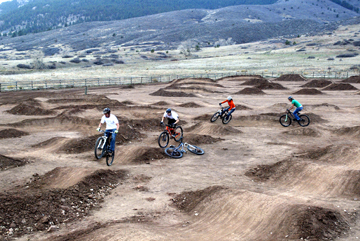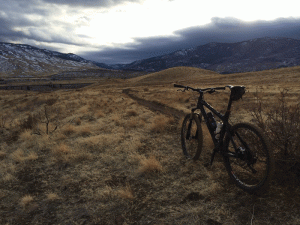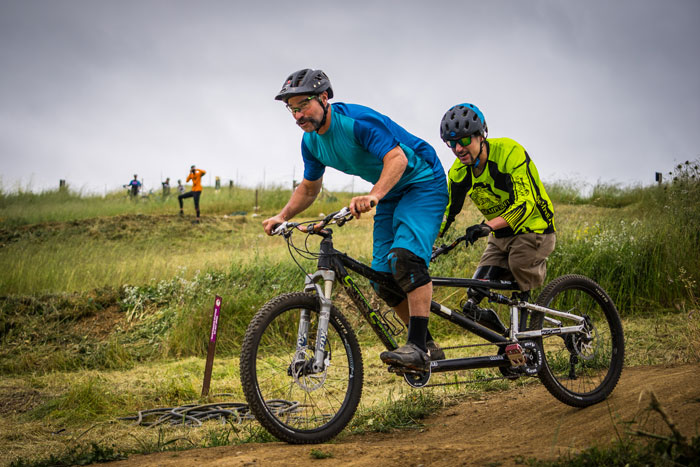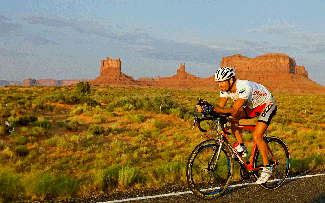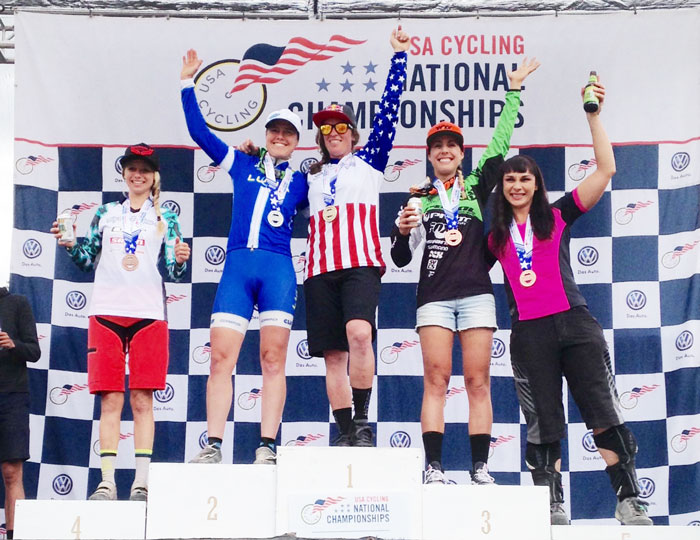- Tahoe’s Nevada Beach Tops the List of Hard-to-Book Campgrounds - 07/17/2024
- Cannabis Watershed Protection Program Cleans Up Illegal Grow Sites - 07/10/2024
- French Fire - 07/05/2024
By Seth Lightcap
“Pumptracks are the new horseshoes.” –Mark Weir, WTB pro mountain bike racer
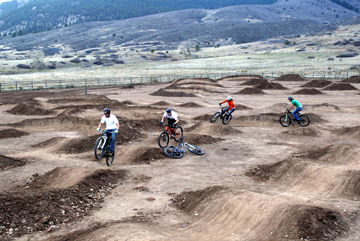
Lory state park in Ft. Collins, CO features a massive pump track playground. www.leelikesbikes.com
Unless you’ve been hanging out by the bike shop water cooler, you might not have heard of the latest craze to hit the mountain bike world – the pump track.
A pump track is a small, looping trail system that you can ride continuously without pedaling. Your speed along the pump track is dependent on your ability to gain momentum by “pumping” the tight terrain transitions of the track.
Once you’ve got your “pump” mastered, the track becomes a freestyle bobsled course complete with steep-bermed corners, smooth rollers, and criss-crossing interconnected lines. Well-built pump tracks allow top riders to complete a lap in less than 30 seconds while hitting top speeds over 20 mph – without a single pedal stroke mind you.
The origins of the pump track are rooted in the hardpack BMX trails of the ‘70s and ‘80s, and recently, in the backyards of Australian downhill racers who created some of the first pump tracks around 2002. The first new era pump track on American soil was built in 2004 at The Fix Bike Shop in Boulder, CO, by pro downhiller Steve Wentz.
Rolling into 2008, pump tracks are popping up in backyards and empty lots all over the world. The word is out that pumping is not only ridiculously fun, but also extremely rewarding. Using as little as 10 x 30 feet of land, a pump track builds confidence, strength, and lightning fast bike handling skills – not to mention the social benefits. Pumpin’ can be a party!
Two of the bike industry’s leading pump track ambassadors are WTB pro racer Mark Weir and racer/journalist Lee McCormack of www.leelikesbikes.com. Both Weir and McCormack were introduced to pump tracks at The Fix, but have since constructed two of the world’s finest pump tracks in their respective backyards.
Weir and McCormack are thrilled by the efficient genius of their sculpted lawns, as their pump tracks provide not only endless cycling fun, but also an amazing workout. Talking with ASJ they couldn’t help but expound on the virtues of pump tracks.
“The pump track is the best skills riding I have done,” said Weir. “It is super physical and builds every muscle in your body. Pumping helps you learn to use the terrain better.”
McCormack, author of a guide to building pump tracks called “Welcome to Pump Track Nation,” describes pump tracks as “xeriscape with a purpose.”
“A pump track requires less maintenance, water, and chemistry than a grass lawn,” quips McCormack. “And it’s great technique training for cycling, skiing, snowboarding, or anything like that.”
The ground level features of a typical pump track keep the stakes relatively low as you learn how to pump. Though crashing on a pump track is not uncommon, proper pump technique, including good terrain anticipation, will usually keep you upright. McCormack discusses learning to pump in his book.
“Pumping is simple,” he says. “Just absorb any surface that faces the way you’re coming from, and push into any surface that faces the way you want to go. Part of this push gets translated into forward motion and, voila, you gain speed.”
The ideal bike for a pump track is a hardtail mountain bike with front suspension. Full-suspension bikes don’t allow you to gain and maintain speed as well because the suspension sucks up your pumping effort. Weir likes his pump track bikes “stiff, with really fast tires.”
Most pump tracks link a series of rollers to steeply bermed corners that bring you back around. Once you can maintain speed through all the features you can experiment with jumping or wheelie-ing rollers or choosing a new line. Creative pump opportunities are only limited by the design of the track and your imagination.
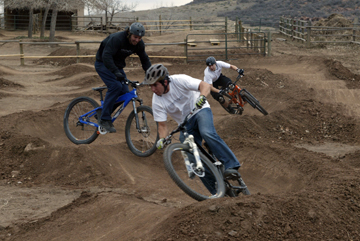
Riders pump the ‘S’ berms at Lory State Park in Ft. Collins, CO. www.leelikesbikes.com
Building a pump track is both as easy and as hard as it looks. It’s true that the tracks are merely collections of small dirt piles, but with all the planning and shoveling it is undoubtedly hard work to create a fast pump track.
A full-sized pump track requires about a 50 x 50 foot plot of flat ground. Sloped land can work too, but you’ll have to consider the slope in your design. As with any construction project, it helps to measure twice and dig once.
McCormack agrees. “I cannot overstress the importance of planning your track,” he says in his book. “If you just start digging you WILL dig yourself into a corner, and you’ll end up making compromises – or starting over. No fun!”
Deciding where to put a roller or berm doesn’t have to obey a blueprint, however. Certain distances between features are known to pump best, but ultimately, the quirks of the land and the vision of those building it will decide the ideal layout. Weir’s track started with no plans and has metamorphosed into a community masterpiece.
“The perfect pump track for me is my own,” Weir said. “It was something that my friends and I built with our own vision … The pump track represents way more than just a place to ride. It is a place that builds friendships and produces creativity.”
Dubbed the Peacock Pit, the pump track in Weir’s Novato backyard has become the Nor Cal poster image for the beauty of social pump track riding. After hosting several “pump” parties where friends, neighbors, and even strangers came to ride his track, Weir and other Novato residents, including project coordinator Sam Neff, sparked a movement to build a public pump track in a local park. Plans for the Novato track are rolling smoothly through the recreation committees, so hopefully this summer the track will be built. Neighboring Mill Valley also has a pump track project in the works, while Folsom has already opened a bike skills park that includes pump-track style features.
No matter whether you’re a North Shore huckster, a single-speed snob, or even a crazy cross racer, spending some quality time pumping on a pump track will surely improve your cycling skills. Biking without pedaling may sound strange, but according to McCormack, that’s the point. “A pump track is a laboratory, it’s non-threatening, and so different from normal riding that it allows you to ride your bike with an entirely new mindset.”
So if you haven’t heard of a pump track near you, keep asking around, or better yet, get digging. You are but a shovel blister away from a chronic case of pump track hysteria.
Check out www.leelikesbikes.com for further info on pump tracks and to order McCormack’s pump track builder’s guide, Welcome to Pump Track Nation.

